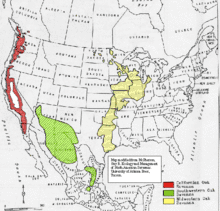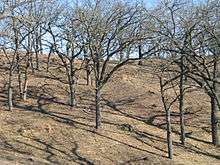Oak savanna

An oak savanna is a type of savanna, or lightly forested grassland, where oaks (Quercus spp.) are the dominant trees. These savannas were maintained historically through wildfires set by lightning or humans, grazing, low precipitation, and/or poor soil.

Although there are pockets of oak savanna almost anywhere in North America where oaks are present, there are three major oak savanna areas: 1) California, Washington and Oregon in the west; 2) Southwestern United States and Mexico; and 3) the prairie/forest border of the Midwest.[1][2] There are also small areas of oak savannas in other parts of the world. (See also Eastern savannas of the United States for information on pine savannas of the U.S. South.)

Midwestern oak savannas
The oak savannas of the Midwestern United States form a transition zone between the arid Great Plains to the west and the moist broadleaf and mixed forests to the east. Oak savannas are found in a wide belt from northern Minnesota and southern Wisconsin, down through Iowa, Illinois, northern and central Missouri, eastern Kansas, and central Oklahoma to north-central Texas, with isolated pockets further east around the Great Lakes including Ontario.[3] The bur oak (Quercus macrocarpa) is the dominant species in northern oak savannas, although black oak (Quercus velutina), white oak (Quercus alba), and Hill's oak (Quercus ellipsoidalis)are sometimes present. The dominant tree in the south is usually the black oak (Quercus velutina), although the chinquapin oak (Quercus muhlenbergii), post oak (Quercus stellata), and black-jack oak (Quercus marilandica) are also common. The flora of the herbaceous layer generally consists of species associated with tallgrass prairies, both grasses and flowering plants, although some woodland species may be present. There are also a few species that are unique to oak savannas.[4][5][6] Oak savannas, because of their mixture of grassland, woodland, and unique savanna species, typically have a higher plant diversity than grasslands and woodlands combined.
History
Before European settlement, the oak savanna, a characteristic fire ecology, was extensive and was often a dominant part of the ecosystem. Fires, set by lightning or Native Americans, ensured that the savanna areas did not turn into forests. Only trees with a high tolerance for fire, principally certain oak species, were able to survive. On sandy soils, black oak (Quercus velutina) predominated. On rich soils bur oak (Quercus macrocarpa) was the major tree in Midwestern North America. These savanna areas provided habitat for many animals, including American bison, elk, and white-tailed deer.
The most fire-tolerant of the oak species is the bur oak (Quercus macrocarpa), which is especially common in hill-country savannas in the Midwest.

European settlers cleared much of the savanna for agricultural use. In addition, they suppressed the fire cycle. Thus surviving pockets of savanna typically became less like savannas and more like forests or thickets. Many oak savanna plant and animal species became extinct or rare.

Restoration
With the rise in interest in environmental conservation, restoration and preservation of surviving areas of oak savanna began. Low intensity, spring prescribed burns have been used since 1964 at the Cedar Creek Ecosystem Science Reserve in Minnesota in an attempt to restore the area to an oak savanna.[7] Burned areas are now more savanna like (having greater grass and forb and lower shrub and lower tree representation) than unburned areas but still have higher overstory densities than apparently existed in presettlement times. Restoration work began in the 1970s in Illinois, followed by work in Wisconsin, Iowa, Missouri, and Minnesota.[8]
Current distribution
Presettlement there was approximately 50,000,000 acres of oak savanna in Midwestern United States, all of it being exclusively in a wide strip stretching from southwestern Michigan to eastern Nebraska and from southern Manitoba to central Texas. After Europeans arrived, fire suppression and settlement diminished the oak savannas to a fraction of their former expanse, which currently exist in many fragmented pockets throughout its native range. Many sites are protected and maintained by government bodies or non-profit organizations such as The Nature Conservancy, the Wisconsin and Minnesota Departments of Natural Resources, and the Iowa Natural Heritage Foundation. Examples include the Neal Smith Wildlife Refuge near Prairie City, Iowa, the Indiana Dunes National Lakeshore in Indiana, numerous State Natural Areas in Wisconsin, the Lake County Forest Preserve District, Cook County Forest Preserve District and Iroquois County State Wildlife Area in Illinois, the Oak Openings Preserve Metropark in Ohio, and Pinery Provincial Park on Lake Huron in Ontario. An excellent example of a restored oak savanna is Wisconsin's Pleasant Valley Conservancy State Natural Area.[9]
References
- ↑ McPherson, Guy R. 1997. Ecology and Management of North American Savannas. University of Arizona Press, Tucson.
- ↑ Anderson, Roger A., Fralish, James S. and Baskin, Jerry M. editors.1999. Savannas, Barrens, and Rock Outcrop Plant Communities of North America. Cambridge University Press.
- ↑ Nuzzo, V.A. 1986. Extent and status of Midwest oak savanna: presettlement and 1985. Natural Areas Journal 6: 6-36.
- ↑ Penfound, W.T. (1962). "The savanna concept in Oklahoma". Ecology. 43: 774–775. doi:10.2307/1933481.
- ↑ Abrams, M.D. (1992). "Fire and the development of oak forests". BioScience. 42: 346–353. doi:10.2307/1311781.
- ↑ Packard, Steve. Just a few oddball species: restoration and the recovery of the tallgrass savanna. 1988. Restoration and Management Notes 6:1, 13-22
- ↑ Research Paper NC-266. St. Paul, MN: U.S. Dept. of Agriculture, Forest Service, North Central Forest Experiment Station
- ↑ Stevens, William K. 1995. Miracle Under the Oaks: The Revival of Nature in America; New York. Pocket Books
- ↑ "Pleasant Valley Conservancy".
External links
- "Upper Midwest forest-savanna transition". Terrestrial Ecoregions. World Wildlife Fund.
- "Central forest-grasslands transition". Terrestrial Ecoregions. World Wildlife Fund.
- Oak Savannas: Characteristics, Restoration, and Long-Term Management
- Pleasant Valley Conservancy State Natural Area (Wisconsin)
- Oak Savannah Documentary produced by Oregon Field Guide